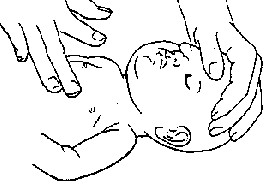6. If your breaths do not cause your child's chest to rise and fall, repeat steps 1 through 3, above, to open the airway again. Give two more puffs of air.
7. If there is still no movement of the chest, the airway is probably blocked. Perform the Heirnlich maneuver as follows: Hold your baby securely, resting face down on your forearm. Rest your forearm on your thigh. Using the heel of your other hand, deliver five quick firm blows between the child's shoulder blades. (You will learn precisely how firm these blows need to be by practicing on a mannequin in your first aid class.) Then turn your child over to face you. With your fingers, give five quick firm compressions to the breastbone, just below the nipple line. Repeat these steps, alternating between five back blows and five chest thrusts, until the object is expelled. Do not stop until the foreign material is expelled and your baby begins coughing, breathing, and making normal sounds, or another person can take over for you, or medical help arrives.
8. If your child loses his pulse during this procedure,
Full CPR
9. Place your baby flat on the floor on his back. Check for a pulse on the brachial artery again. Only if your child's heart has stopped beating and you can't feel a pulse can you safely begin CPR. Never do chest compressions on a child with a heartbeat.
10. If your baby is not breathing and does not have a pulse, give compressions. Locate the spot to give compressions by placing two or three fingers on your infant's chest just below the nipple line (see Figure 3.4). Keep your elbows straight and your shoulders lined up over your infant's body. Maintain this position so that the compressions are done straight up and down on your baby's chest. For each compression, push your baby's breastbone down with your fingers the equivalent of 1/3 to 1/2
of total chest height (approximately 1/2-1 inch) straight down. Do not rock your body. Do not move into your child's chest diagonally. Release the pressure between compressions without taking your fingers off his chest.
11. Perform cycles of chest compressions and respirations. For an infant, a complete cycle consists of at least 5 chest compressions followed by 1 breath. Give at least 20 breaths per minute (1 breath every 3 seconds) and 100 compressions per minute. Count aloud to help you maintain a steady rhythm: One one-thousand, two one-thousand, three one-thousand, four one-thousand, five one-thousand, and BREATH, and so on.
 Figure 3.4 Locating the Spot for Compressions on an Infant
Figure 3.4 Locating the Spot for Compressions on an Infant
Place two or three fingers on your baby's chest just below the nipple line.
12. After giving CPR for one minute, check your infant's brachial pulse again. If you feel a pulse, stop doing chest compressions and check for breathing. If there is no pulse, continue performing CPR. Continue to check for a pulse and breathing every few minutes until emergency medical help arrives. Do not stop CPR until your child starts breathing on his own, or someone else can take over for you, or emergency help arrives.
13. If your infant begins breathing on his own, discontinue CPR. Once his pulse and breathing have been restored and the immediate crisis is over, check and treat your baby for bleeding, broken bones, or any other injury or problem he might have.